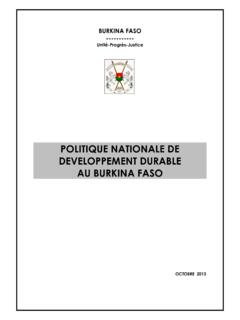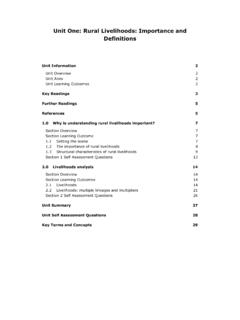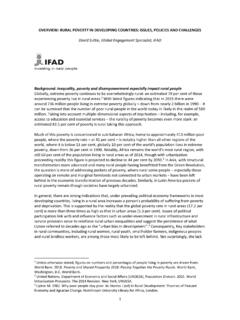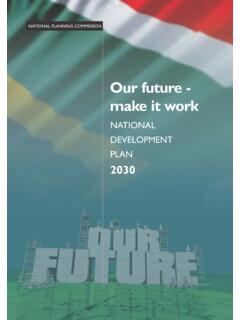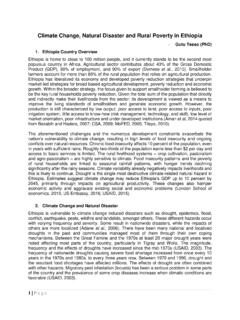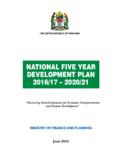Transcription of Module 1 Introduction to the Green Economy Approach
1 8 | P a g e Module 1 Introduction to the Green Economy Approach 9 | P a g e Module 1: Introduction to the Green Economy Approach Overview of Module 1 Module 1 presents an Introduction to the Green Economy . It describes some of the international discussions that have given rise to the term and discusses varying definitions. This Module presents a rationale for moving toward a Green Economy by describing current prevailing conditions which are not meeting the environmental, economic and social goals of sustainable development. The Module examines the drivers and opportunities for change in the Caribbean that have led towards embracing a Green Economy Approach and identifies some challenges to do so. This Module also describes linkages between the natural environment and major economic sectors to provide a basis for understanding some of the necessary changes that must be made.
2 Objectives of Module 1 The objectives of Module 1 are to: Generate discussion about concepts, definitions and principles related to a Green Economy within the Caribbean context Make the case for moving toward a Green Economy Identify drivers within the Caribbean which are facilitating the move toward a Green Economy Discuss barriers that must be overcome to transition to a Green Economy Examine ways of strengthening and supporting intra-Caribbean and intra-SIDS cooperation on the Green Economy 10 | P a g e Green Economy Definitions and Concepts One of the most commonly accepted definitions of a Green Economy (GE) is the one put forward by the United Nations Environment Programme (UNEP) and promoted through its Green Economy Initiative2. UNEP defines a Green Economy as one that results in improved human well-being and social equity, while significantly reducing environmental risks and ecological scarcities.
3 The concept of a Green Economy has its origins in discussions around environment and development that led to the discussion and promotion of the term sustainable development at the 1992 United Nations Conference on Environment and Development (UNCED) in Rio de Janeiro (known also as the Rio Summit or Earth Summit). The term was revived and entered the international development discourse following the global financial crisis of 2008, as national governments and international organizations grappled with ways to reboot the Economy in a more sustainable way. Several countries launched Green stimulus programmes, which were essentially public sector incentive packages for private investment in Green energy sources and technologies. UNEP was an early champion, launching its GE Initiative in October 2008. The GE concept has also resonated in climate change mitigation discussions and it has become an important theme in the United Nations Framework Convention on Climate Change (UNFCCC) negotiations.
4 The concept of a Green Economy is related to the ideas of Green growth and low-carbon development as shown in the table below. Green Economy Green Growth Low-carbon Development A transition towards an economic model based on the sustainable generation of equitable social, environmental and economic benefits The potential of Green sectors and industries as engines of growth Development emphasizing reduction in use of fossil fuels as the engine for development (also referred to as climate-resilient development) 2 UNEP Green Economy Initiative 11 | P a g e Definitions of a Green Economy There are a number of different definitions of a Green Economy that emphasize different aspects. Some definitions (including the UNEP definition above) are: A GE is one that results in improved human well-being and social equity, while significantly reducing environmental risks and ecological scarcities (UNEP) a GE is an Economy in which economic growth and environmental sustainability work together in a mutually reinforcing fashion while supporting progress on social development (International Chamber of Commerce Green Economy Task Force) Green growth means fostering economic growth and development, while ensuring that natural assets continue to provide the resources and environmental services on which our well-being relies.
5 It focuses on the synergies and tradeoffs between the environmental and economic pillars of sustainable development ( Green Growth Knowledge Platform) Low carbon development strategies are forward-looking national economic development plans or strategies that encompass low-emission and/or climate-resilient economic growth (OECD)3 The concept of a Green Economy supports and does not replace sustainable development. But this new focus responds to two recent developments: There is a deeper appreciation today by many governments, companies, civil society and the public that we are reaching planetary limits, not just in terms of greenhouse gas emissions but also in our use of water, land, forests and other natural resources. The environmental and social costs of our current economic model are becoming more and more apparent. The global recession has led to a reconsideration of key tenets of the current economic model and adoption by a number of countries of programmes to promote Green energy sources and to develop new markets and industries that can create good, long-term jobs The promotion of a Green Economy was a key theme at the Rio+20 Conference held in June 2012 to mark the 20th anniversary of the Rio Summit.
6 Governments agreed at Rio+20 to frame the Green Economy as an important tool for sustainable development one that is inclusive and can drive economic growth, employment, and poverty eradication, whilst maintaining the healthy functioning of the Earth s ecosystems. Principles of a Green Economy While definitions are useful for interpretation of the Green Economy concept, there has been an attempt to move beyond simple definitions of the Green Economy to define a set of guiding principles. These principles help to guide practitioners in the application of the Green Economy concept. 3 12 | P a g e A number of sets of Green Economy principles were published by a variety of organizations in the lead up to Rio+20. An analysis of eight sets of principles was conducted by the United Nations Division for Sustainable Development that year (UNDESA, 2014).
7 It found that there is a considerable diversity of principles that have been proposed to enhance interpretation and application of the Green Economy . However, there is also considerable synergy amongst the different sets of principles. The list of the most common Green Economy principles identified in the review are shown below. Common Green Economy Principles 1. The Green Economy is a means for achieving sustainable development. 2. The Green Economy should create decent work and Green jobs. 3. The Green Economy is resource and energy efficient. 4. The Green Economy respects planetary boundaries or ecological limits or scarcity. 5. The Green Economy uses integrated decision making. 6. The Green Economy measures progress beyond GDP using appropriate indicators/metrics. 7. The Green Economy is equitable, fair and just between and within countries and between generations.
8 8. The Green Economy protects biodiversity and ecosystems. 9. The Green Economy delivers poverty reduction, well being, livelihoods , social protection and access to essential services. 10. The Green Economy improves governance and the rule of law. It is inclusive; democratic; participatory; accountable; transparent; and stable. 11. The Green Economy internalizes externalities. 13 | P a g e The Green Economy in the Caribbean Context Green Economy Discussions in the Caribbean The Caribbean has embraced elements of a Green Economy for some time through regional initiatives focusing on issues such as climate change, renewable energy and sustainable tourism. More recently, national policies have been developed in several Caribbean countries as leaders and decision makers seek to support sustainable development, sustainable energy and climate resilience. Examples of regional and national initiatives that promote a Green Economy Regional Initiatives CARICOM renewable energy programmes including the 1998 Caribbean Renewable Energy Development Programme (CREDP) that seek to reduce carbon emissions and promote the development of renewable energy Caribbean Sustainable Energy Roadmap and Strategy (C-SERMS) Framework within which initial targets for the contribution of renewable energy to total electricity generation have been established Caribbean Alliance for Sustainable Tourism (CAST)
9 Established by members of the Caribbean Hotel Association in 1997 to promote responsible environmental and social management of natural and heritage resources respectively, within the hotel and tourism sector CARICOM s regional framework for climate resilient development implemented by the Caribbean Community Centre for Climate Change (CCCCC) Caribbean Natural Resources Institute (CANARI) Sustainable Rural livelihoods Programme established in 2011 to support rural communities with the development of sustainable natural resource-based livelihoods through building capacity, catalysing partnerships and influencing policy to create an enabling institutional environment. UNEP s GE Initiative (GEI) - launched in late 2008 - with an overall objective to provide the analysis and policy support for investing in Green sectors and in greening environmental unfriendly sectors.
10 Regional dialogue in 2009-2012 facilitated by CANARI to elicit ideas from a wide cross-section of Caribbean stakeholders on what Green Economy means in the Caribbean context (CANARI, 2012). The aim of this initiative was to facilitate the emergence of the Caribbean s own unique development pathway and to inform international understanding and action. In 2009 the late Prime Minister of Barbados David Thompson stated his aim to make Barbados the most environmentally advanced Green country in Latin America and the Caribbean - Barbados Advocate 31 March 2009 14 | P a g e Regional Initiatives Caribbean GE Action Learning Group (GE ALG), established in 2010, which was charged with identifying and promoting ways in which a a Caribbean Green Economy can advance sustainable development in the Caribbean. Green Economy Caribbean Political Advisory Group (GEPAG) formed in 2014 and charged with undertaking research, outreach and capacity building in the public and private sectors in key areas that are needed to support different steps of a Green Economy transition.

